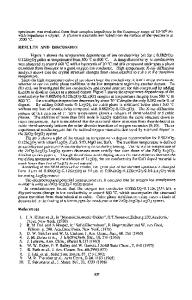Surface Plasmon Assisted Luminescence Enhancement of Ag NP/NWs-Doped SiO 2 -TiO 2 -ZrO 2 :Eu 3+ Ternary System
- PDF / 2,377,348 Bytes
- 11 Pages / 595.276 x 790.866 pts Page_size
- 23 Downloads / 419 Views
Surface Plasmon Assisted Luminescence Enhancement of Ag NP/NWs-Doped SiO2-TiO2-ZrO2:Eu3+ Ternary System Prakashan V. P. 1 & Sajna M. S. 1 & Gejo G. 1 & Sanu M. S. 1 & Saritha A. C. 1 & Biju P. R. 1 & Cyriac J. 1 & Unnikrishnan N. V. 1 Received: 3 July 2018 / Accepted: 27 August 2018 # Springer Science+Business Media, LLC, part of Springer Nature 2018
Abstract Non-hydrolytic sol-gel process was employed to prepare Eu3+-doped and silver nanoparticles/nanowires (Ag NP/NWs) co-doped SiO2-TiO2-ZrO2 ternary matrix. XRD, TEM, and SAED analyses revealed that the matrix is of amorphous nature even the crystalline nanoparticles/nanowires are embedded. The formation of ternary matrix is further evidenced by the characteristic peaks in FTIR spectrum and EDS analysis. The emission intensity is enhanced by sixfold for Ag NPs and eightfold for Ag NWs embedded matrix and is probably due to Surface Plasmon Coupled Emission (SPCE). Above the critical concentration of 1 wt.% Ag NP and 1.5 wt.% Ag NW, the emission intensity starts to diminish because of quenching effects. CIE chromaticity studies confirm that the addition of Ag NP/NWs into Eu3+-doped ternary matrix does not alter the color coordinates and purity of the present system. These Eu3+-Ag NP/NWs-doped ternary systems could be used as a promising material for efficient red light emitting sources, bio-detection, and plasmonic sensor applications. Keywords Sol-gel . Surface Plasmon Resonance . Surface Plasmon Coupled Emission . Luminescence
Introduction Sol-gel-derived optically transparent matrices doped with trivalent rare earths are attaining a great deal of interest among researchers for several years due to their versatile features [1, 2]. Compared to binary oxides of SiO2, TiO2, and ZrO2, the respective ternary oxides have attracted many industrial applications due to their superior properties like increased rates of spectrum intensity, energy transfer, photostability, fluorophore decay rate, and multiphoton excitation [3–6]. In recent years, much more interest has been devoted to enhance the optical properties of these systems by co-doping with other rare earths, transition metals, metal nanoparticles, semiconductor materials, etc. Co-doping of metal nanoparticles with rareearth ions has received much attention because of its Surface Plasmon Resonance (SPR) effects [7]. The collective oscillations of conduction electrons of noble metal nanoparticles with incident light otherwise referred to as Surface Plasmon (SP) find large area of potential applications in different fields such as electronics, optical and magnetic * Unnikrishnan N. V. [email protected] 1
School of Pure and Applied Physics, Mahatma Gandhi University, Kottayam 686 560, India
devices, sensors, surface-enhanced Raman scattering, nanosized optics etc. [8–12]. Recent research has revealed that metallic particles can be structured and characterized at the nanolevel and this in turn has renewed interest in Surface Plasmons [13]. Enhanced local fields and fluorescence may result from the strong incident ligh
Data Loading...











